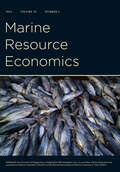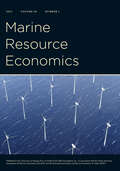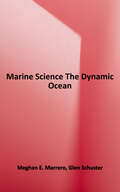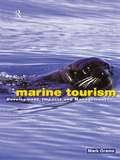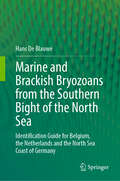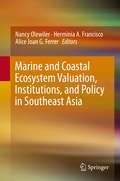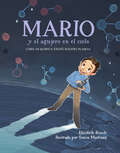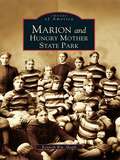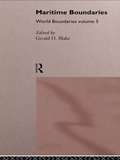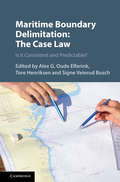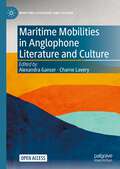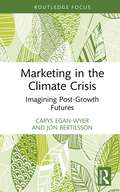- Table View
- List View
Marine Resource Economics, volume 39 number 4 (October 2024)
by Marine Resource EconomicsThis is volume 39 issue 4 of Marine Resource Economics. Marine Resource Economics (MRE) publishes creative and scholarly economic analyses of a range of issues related to natural resource use in the global marine environment. The scope of the journal includes conceptual and empirical investigations aimed at addressing real-world ocean and coastal policy problems. MRE is an outlet for early results and imaginative new thinking on emerging topics in the marine environment, as well as rigorous theoretical and empirical analyses of questions that have long interested economists who study the oceans. A pluralistic forum for researchers and policy makers, MRE encourages challenges to conventional paradigms and perspectives. The journal is comprised of five sections: Articles, Perspectives, Case Studies, Systematic Reviews, and Book Reviews.
Marine Resource Economics, volume 40 number 1 (January 2025)
by Marine Resource EconomicsThis is volume 40 issue 1 of Marine Resource Economics. Marine Resource Economics (MRE) publishes creative and scholarly economic analyses of a range of issues related to natural resource use in the global marine environment. The scope of the journal includes conceptual and empirical investigations aimed at addressing real-world ocean and coastal policy problems. MRE is an outlet for early results and imaginative new thinking on emerging topics in the marine environment, as well as rigorous theoretical and empirical analyses of questions that have long interested economists who study the oceans. A pluralistic forum for researchers and policy makers, MRE encourages challenges to conventional paradigms and perspectives. The journal is comprised of five sections: Articles, Perspectives, Case Studies, Systematic Reviews, and Book Reviews.
Marine Resource Economics, volume 40 number 2 (April 2025)
by Marine Resource EconomicsThis is volume 40 issue 2 of Marine Resource Economics. Marine Resource Economics (MRE) publishes creative and scholarly economic analyses of a range of issues related to natural resource use in the global marine environment. The scope of the journal includes conceptual and empirical investigations aimed at addressing real-world ocean and coastal policy problems. MRE is an outlet for early results and imaginative new thinking on emerging topics in the marine environment, as well as rigorous theoretical and empirical analyses of questions that have long interested economists who study the oceans. A pluralistic forum for researchers and policy makers, MRE encourages challenges to conventional paradigms and perspectives. The journal is comprised of five sections: Articles, Perspectives, Case Studies, Systematic Reviews, and Book Reviews.
Marine Resource Economics, volume 40 number 3 (July 2025)
by Marine Resource EconomicsThis is volume 40 issue 3 of Marine Resource Economics. Marine Resource Economics (MRE) publishes creative and scholarly economic analyses of a range of issues related to natural resource use in the global marine environment. The scope of the journal includes conceptual and empirical investigations aimed at addressing real-world ocean and coastal policy problems. MRE is an outlet for early results and imaginative new thinking on emerging topics in the marine environment, as well as rigorous theoretical and empirical analyses of questions that have long interested economists who study the oceans. A pluralistic forum for researchers and policy makers, MRE encourages challenges to conventional paradigms and perspectives. The journal is comprised of five sections: Articles, Perspectives, Case Studies, Systematic Reviews, and Book Reviews.
Marine Resource Economics, volume 40 number 4 (October 2025)
by Marine Resource EconomicsThis is volume 40 issue 4 of Marine Resource Economics. Marine Resource Economics (MRE) publishes creative and scholarly economic analyses of a range of issues related to natural resource use in the global marine environment. The scope of the journal includes conceptual and empirical investigations aimed at addressing real-world ocean and coastal policy problems. MRE is an outlet for early results and imaginative new thinking on emerging topics in the marine environment, as well as rigorous theoretical and empirical analyses of questions that have long interested economists who study the oceans. A pluralistic forum for researchers and policy makers, MRE encourages challenges to conventional paradigms and perspectives. The journal is comprised of five sections: Articles, Perspectives, Case Studies, Systematic Reviews, and Book Reviews.
Marine Science
by Michael E. Huber Peter CastroThe first edition of Marine Science became an instant beloved text with its full coverage of oceanography, stunning design, student-friendly learning system, and data analysis labs. <p><p>Now in its second edition, the program further expands its NGSS coverage, ELL support, interdisciplinary applications, and introduces a broader focus on human and environmental interaction.
Marine Science
by Thomas F. GreeneWritten for high school students, this book provides complete coverage of a one-year high school course in marine biology/oceanography.
Marine Science for Kids: Exploring and Protecting Our Watery World, Includes Cool Careers and 21 Activities
by Bethanie Hestermann Josh Hestermann Stephanie ArneDo you ever dream of being a marine explorer or adventurer? Are you a fan of cool, cute, or creepy creatures? Then here's some good news: some of the coolest, cutest, and creepiest creatures live in Earth's oceans and other watery places.Marine Science for Kids is a colorful, fun, photo-filled guide to exploring our underwater world. In these pages, you'll delve deep into the science of aquatic study, including geology, chemistry, and biology in both salt- and freshwater environments, and gain insight into the real-world practice of aquatic science. You'll discover how and why oceans move, and learn the answers to questions such as "Why is the ocean blue?" You'll meet cool creatures, including sharks and rays, penguins and other seabirds, whales and dolphins, squids and octopuses, and many more. You'll uncover some of the most pressing challenges facing marine environments and find out how you can use your talents to make a difference. Real-life marine scientists share what inspires them every day and provide insights into their exciting careers. Hands-on activities in each chapter make learning fun.Kids can: make an edible coral reef; explore marine camouflage; construct a water-propelled squid; test methods of cleaning up an oil spill; experiment with ocean acidification; and much more.
Marine Science: Marine Biology and Oceanography
by Thomas F. GreeneThis book introduces the wonders of marine life and ocean environments with this engaging and fun-to-read program.
Marine Science: The Dynamic Ocean
by Glen Schuster Meghan E. MarreroThis book is a truly integrated science course in which the science concepts are applied to authentic scientific settings, scenarios, and investigations. You will simultaneously learn about life, Earth, and physical sciences. As you explore real-world data, you get a unique and fresh perspective on the ocean, its inhabitants, and its processes. Science concepts such as plate tectonics, food and energy transfer, and the properties of water come to life as you participate in Student Expert teams that focus on the seafloor, marine food sources, and the sea's surface. <p><p>This curriculum program parallels other textbook programs, yet there are some notable distinctions in the way it was put together. Rather than chapters, the book is divided into 34 Lessons, each of which will help you to build your understanding about the ocean and its processes. Marine Science: The Dynamic Ocean gives you the opportunity to access and interpret data sets, including oceanographic, meteorological, and animal tracking observations. You will also participate in fieldwork, assessing local water quality and your school's potential contribution to marine pollution.
Marine Tourism: Development, Impacts and Management (Routledge Advances in Tourism)
by Mark OramsMarine Tourism examines both successful and unsuccessful tourism in coastal and marine environments. The author provides an overview of the history, development and growth of marine tourism and describes the characteristics of 'marine tourists' and the 'vendors' of these tourist activities. The book includes case studies of specific types of tourism including:* the cruise ship industry, * whale and dolphin watching,* yachting - the America's Cup,* personal water crafts and other water sports* and maritime museums and festivals. in locations including Brighton, UK, the Florida Keys and Hawaii, USA Caribbean islands, New Zealand and Australia's Great Barrier Reef. The final section examines tourism impacts on marine ecosystems and coastal communities and explores management techniques aimed at reducing negative impacts and maximizing the benefits of marine tourism.
Marine and Brackish Bryozoans from the Southern Bight of the North Sea: Identification Guide for Belgium, the Netherlands and the North Sea Coast of Germany
by Hans De BlauweIn 2009, Hans published a Dutch identification guide for marine and brackish water Bryozoans (&“moss animals&”) of the Southern Bight of the North Sea, illustrated with drawings, scanning-electron and light microscope images. It is a reliable reference for professional bryozoologists and keen amateur naturalists studying northern European bryozoans. This virtually complete inventory of a group of animals that have been the object of very few studies so far, but that encompasses a surprisingly large variety of species. The sandy substrate that is predominant in this area is usually poor in moss animal species. The fact that such a large number of species are described in this work is the result of an in-depth study of recent observations (tidemark material, specimens collected on the hard substrate of breakwaters and port structures, shells and stones near sandbanks) and the review of historical collections. As many as 179 species were discussed in the Dutch book, the present English update treats 201 species, describing 9 species as new to science. The area bounded to the south by Cap Gris Nez (Northern France) covers the Belgian and Dutch coast and is now extended to the German North Sea coast. This update includes more native and non-indigenous species, new distribution data, new taxonomic insights, additional references, and additional or better illustrations. What is especially remarkable is that each species has been illustrated using both stereomicroscope showing natural coloration and colony shape, and scanning electron microscope showing small details of zooidal morphology. Thanks to the different identification keys in the book and a 20-30x magnifying glass, it is possible to recognize most of the moss animals in the study area. We hope that this work will contribute to a better understanding of this colony-forming, undervalued group of animals.
Marine and Coastal Ecosystem Valuation, Institutions, and Policy in Southeast Asia
by Herminia A. Francisco Nancy Olewiler Alice Joan G. FerrerThis book is a compendium of case studies illustrating how economic tools and techniques can be used to address a wide range of problems in the management and conservation of marine and coastal ecosystems in a developing country context. The studies, which were conducted with support from the Economy and Environment Program for Southeast Asia (EEPSEA), cover topics such as mobilizing conservation finance from beneficiaries of marine and coastal ecosystem services; quantifying ecosystem damage and its impact on dependents of ecosystem resources and services; determining the best package of policy reforms that put a price on pollution and regulate economic activities generating pollution with the goal of restoring coastal and marine resources; and analyzing community-based institutions that support sustainable management of fisheries and coastal resources. Studies in the book also provide general guidelines for conducting economic appraisals. It is essential reading for teachers, researchers, students and practitioners in fishery economics, economic development, ecosystem management, and other key issues facing policymakers in the Southeast Asian region.
Marine and Coastal Resources of India: Selected Case Studies (Sustainable Development Goals Series)
by Srikumar ChattopadhyayThis edited volume covers a wide variety of topics related to the geomorphology of India&’s coasts, India&’s coastal resources, and the human and physical sciences surrounding both. The contents of this book consist of thirty three scholarly articles including introduction and conclusion contributed by academics and professionals, mostly from India. The work presented here is multidisciplinary, with contributors coming from geography, geology, marine geology, oceanography, fishery, agriculture, engineering, management, forestry and other allied disciplines. The papers contributed by experts from the respective fields discuss a wide range of subject matters dealing with some of the crucial aspects of marine and coastal resources, including importance of the Indian Ocean and blue economy in Indian&’s future development. This book will be useful for academics, professionals, researchers and students interested in marine and coastal resource management.
Mario and the Hole in the Sky: How a Chemist Saved Our Planet
by Elizabeth RuschThe true story of how a scientist saved the planet from environmental disaster.Mexican American Mario Molina is a modern-day hero who helped solve the ozone crisis of the 1980s. Growing up in Mexico City, Mario was a curious boy who studied hidden worlds through a microscope. As a young man in California, he discovered that CFCs, used in millions of refrigerators and spray cans, were tearing a hole in the earth's protective ozone layer. Mario knew the world had to be warned--and quickly. Today Mario is a Nobel laureate and a recipient of the Presidential Medal of Freedom. His inspiring story gives hope in the fight against global warming.
Mario y el agujero en el cielo: Cómo un químico salvó nuestro planeta
by Elizabeth RuschUna historia real sobre un científico contemporáneo que salvó la capa de ozono y el planeta, evitando un desastre en el medioambiente.Mario Molina es un científico mexicoamericano y un héroe de nuestros días que ayudó a resolver la crisis de la capa de ozono de la década de 1980. Se crió en la Ciudad de México y desde niño sintió curiosidad por los mundos ocultos que estudiaba a través de un microscopio. De joven, ya viviendo en California, descubrió que el clorofluorocarbono, o CFC, que se usa en millones de refrigeradores y aerosoles, estaba haciendo un agujero en la capa de ozono que protege la Tierra. Mario tuvo que alertar al mundo... ¡y rápido! Mario fue galardonado con el premio Nobel y con la Medalla Presidencial de la Libertad. Su inspiradora historia es una esperanza en la lucha contra el calentamiento global.
Marion and Hungry Mother State Park (Images of America)
by Kenneth Wm. HeathSituated in Virginia's southwestern corner in the splendor of the Blue Ridge Mountain Highlands, Marion and neighboring Hungry Mother State Park are steeped in natural beauty. Marion, the name chosen to honor American Revolutionary War hero Gen. Francis Marion, was officially incorporated by the General Assembly on March 15, 1849. The railroad arrived in 1856 and fueled the economy by promoting industrial growth throughout the region. In 1933, John D. and Mildred Lincoln donated 1,881 acres to the state for the establishment of a state park on Hungry Mother Creek. On June 13, 1936, the park was officially dedicated with public opening ceremonies at Hungry Mother State Park, and more than 5,000 turned out to see the park as Gov. George Peery and State Park Director Robert Burson officiated.
Maritime Boundaries: World Boundaries Volume 5 (World Boundaries Series #Vol. 5)
by Gerald H. BlakeThe global political map is undergoing a process of rapid change as former states disintegrate and new states emerge. At sea, boundary delimitation between coastal states is continuing unabated. These changes could pose a threat to world peace if they are not wisely negotiated and carefully managed. Maritime Boundaries presents a variety of cases illustrating the implications of recent approaches to maritime territorial juristiction.
Maritime Boundary Delimitation: Is It Consistent and Predictable? (Publications On Ocean Development Ser. #24)
by Oude Elferink Alex G. Tore Henriksen Signe Veierud BuschThe law of maritime delimitation has been mostly developed through the case law of the International Court of Justice and other tribunals. In the past decade there have been a number of cases that raise questions about the consistency and predictability of the jurisprudence concerning this sub-field of international law. <P><P>This book investigates these questions through a systematical review of the case law on the delimitation of the continental shelf and the exclusive economic zone. Comprehensive coverage allows for conclusions to be drawn about the case law's approach to the applicable law and its application to the individual case. Maritime Boundary Delimitation: The Case Law will appeal to scholars of international dispute settlement as well as practitioners and academics interested in the law concerning the delimitation of maritime boundaries.
Maritime Mobilities in Anglophone Literature and Culture (Maritime Literature and Culture)
by Alexandra Ganser Charne LaveryThis open access edited collection explores various aspects of how oceanic im/ mobilities have been framed and articulated in the literary and cultural imagination. It covers the entanglements of maritime mobility and immobility as they are articulated and problematized in selected literature and cultural forms from the early modern period to the present. In particular, it brings cultural mobility studies into conversation with the maritime and oceanic humanities. The contributors examine the interface between the traditional Eurocentric imagination of the sea as romantic and metaphorical, and the materiality of the sea as a deathbed for racialized and illegalized humans as well as non-human populations
Maritime Networks in the Mycenaean World
by Thomas F. TartaronIn this book, Thomas F. Tartaron presents a new and original reassessment of the maritime world of the Mycenaean Greeks of the Late Bronze Age. By all accounts a seafaring people, they enjoyed maritime connections with peoples as distant as Egypt and Sicily. These long-distance relations have been celebrated and much studied; by contrast, the vibrant worlds of local maritime interaction and exploitation of the sea have been virtually ignored. Dr. Tartaron argues that local maritime networks, in the form of "coastscapes" and "small worlds," are far more representative of the true fabric of Mycenaean life. He offers a complete template of conceptual and methodological tools for recovering small worlds and the communities that inhabited them. Combining archaeological, geoarchaeological, and anthropological approaches with ancient texts and network theory, he demonstrates the application of this scheme in several case studies. This book presents new perspectives and challenges for all archaeologists with interests in maritime connectivity.
Maritime Transportation: Safety Management And Risk Analysis
by Svein KristiansenFirst Published in 2005. Routledge is an imprint of Taylor & Francis, an informa company.
Marketing and Supply Chain Management: A Systemic Approach
by Dimitris Folinas Thomas FotiadisOrganizations are now recognizing the importance of demand-supply integration to their growth and success. While marketing and supply chain management are an essential part of any business qualification, it is becoming increasingly essential to understand the need for integration between synergize marketing and SCM. Marketing and Supply Chain Management is among the first to synergize these two disciplines. Its holistic approach provides students with a macro-level understanding of these functions and their symbiotic relationship to one another, and demonstrates how both can be managed synergistically to the benefit of the organization. This bridge-building textbook is ideal for students of marketing, logistics, supply chain management, or procurement who want to understand the machinations of business at a macro level.
Marketing for Sustainable Development: Rethinking Consumption Models
by Sihem DekhiliMany people see a weak association between marketing and sustainable development and even consider them as two incompatible fields. However, marketing benefits from an extremely powerful position to encourage transformations at the production level and to guide consumers towards responsible behaviors. From its inception, marketing has been positioned as a support for the relationship between the company and its customers, with the quest for well-being set in the very foundations of the discipline. In a context that is marked by crises and much skepticism, marketing today should, more than ever, prove that it acts in good faith. This book offers practitioners, public authorities, professors and students illustrations that demonstrate that the dissemination of sustainable practices is indeed a marketing issue. It argues that it is particularly important not only to overcome the divide between the concepts of marketing and sustainability, but also to use marketing tools and frameworks to support sustainable development and strengthen the green market.
Marketing in the Climate Crisis: Imagining Post-Growth Futures (Routledge Studies in Critical Marketing)
by Carys Egan-Wyer Jon BertilssonAre marketers, the proponenst for continuous economic growth, the ultimate climate criminals? So far, their job has been to create unnecessary demand and to promote the overconsumption and waste that threatens our very existence on this planet. In this book however, the authors explore the potential of marketing to do the opposite–that is to help create a more ecologically sustainable future. This book argues that marketing researchers and practitioners have a crucial role to play in reimagining and promoting alternatives to growth capitalism.Existing sustainability narratives focus on sacrifice and limitation, rendering potential futures uninspiring and unappealing. Drawing on critical marketing scholarship and degrowth principles, this book proposes an alternative way of thinking—dystopian optimism—which allows us to imagine degrowth as desirable. The authors suggest that the transition to a post-growth future can be achieved by theoretically reimagining that future and outline practical ways for critical marketers to contribute to this transition. This book adds to the small but growing stream of marketing literature that concerns itself with marketing’s role in the currently unfolding ecological calamity. Marketers and marketing researchers will learn how marketing’s role in the calamity is threatening its legitimacy but, by following the chapter-by-chapter analysis, they will also learn how marketing can transform itself by focusing on selling sustainable futures.This book is essential reading for those who want to understand why it is so hard for us to imagine desirable, sustainable futures and who want to be part of changing that. For those who are interested in saving, not just marketing’s legitimacy, but also the planet, it is a must read for scholars and upper-level students of critical marketing, marketing ethics, marketing theory, and consumer culture.
